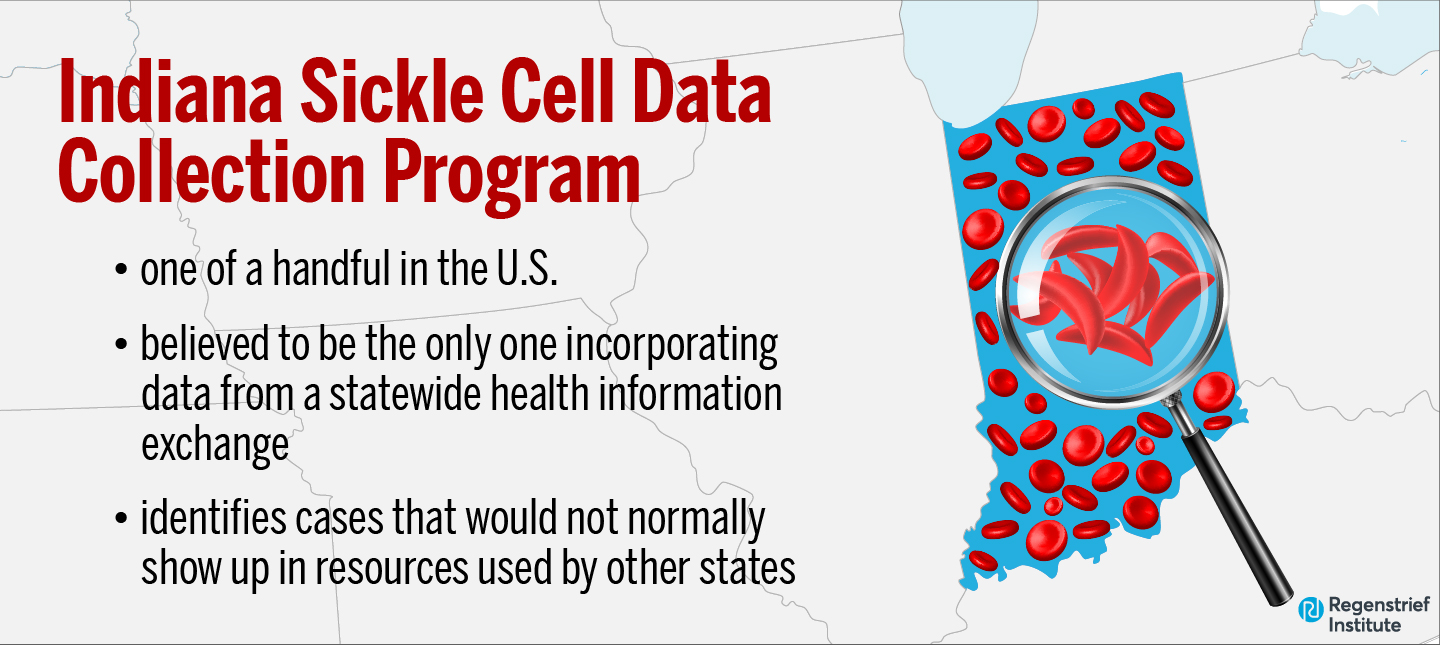Interactive dashboard will debut later this year
A newly published paper describes the development of the Indiana Sickle Cell Data Collection program and presents the most detailed reporting on the prevalence and geographic distribution of persons living with sickle cell disease in the state. The program is one of only a handful of sickle cell data collection programs in the U.S. and is believed to be the only one incorporating data from a statewide health information exchange.
Using deidentified data, the program detected 1,695 persons in Indiana with sickle cell disease. Median age was 21 years and 87 percent were Black. A majority resided within metropolitan counties including those home to Indianapolis and Gary.
This baseline information and the program’s future surveillance efforts will help inform clinical care, identify gaps in coverage and access to care and provide guidance for legislators, community-based organizations and others. It may also potentially decrease healthcare deserts, emergency department utilization and other burdens for individuals and the healthcare system.
In addition to electronic health record data from the Indiana Network for Patient Care, which contains information on more than 20 million patients throughout the state and is one of the nation’s largest health information exchanges, Medicaid data from the Indiana Family and Social Services Administration; clinical data from the Indiana Hemophilia and Thrombosis Center, which cares for many persons with sickle cell disease; and public health data from the Indiana Department of Health were linked. Regenstrief Institute contributed data analysis expertise and provided guidance on use of the data to support public health surveillance. This process will continue on an annual basis.
The Indiana Network for Patient Care is managed by the Indiana Health Information Exchange and is one of the largest health information exchanges in the nation. Regenstrief created the INPC and provides access to data for research purposes.
“What’s new and different about our registry is that we use the Indiana Network for Patient Care data to help identify cases that would not normally show up in resources that the other states have used, enabling more comprehensive anonymous identification of cases throughout Indiana,” said Regenstrief Institute and Indiana University Fairbanks School of Public Health researcher Brian Dixon, PhD, MPA, a co-author of the study. “These cases include individuals who did not receive screening at birth for various reasons, individuals moving into Indiana, some individuals who are receiving care for sickle cell disease from primary care physicians or others who have fallen out of care.
“Managing sickle cell disease is a challenge. Prevalence and surveillance data can be used to identify where there are groups of patients in the state that need access to specialized healthcare. This will enable our partners in state government to look at where there may be unmet needs that can be addressed to help this population. Healthcare systems, payors and others are also interested,” Dr. Dixon noted.
States commonly maintain registries for chronic diseases including cancer and diabetes but not sickle cell disease. The new Indiana Sickle Cell Data Collection program is supported by the U.S. Centers for Disease Control and Prevention.
Later this year, Regenstrief Institute plans to unveil a publicly available interactive sickle cell disease dashboard that will enable interested individuals, community organizations, healthcare providers and others to track the prevalence of sickle cell disease in Indiana by county and understand the health behaviors of those living with the disease.
“Increasing Visibility of Sickle Cell Disease in Indiana: Baseline Prevalence using Integrated Data from Multiple Sources” is published in the peer-reviewed Public Health Reports, the official journal of the Office of the U.S. Surgeon General and the U.S. Public Health Service.
Authors and affiliations
Okolo, Amanda, Indiana Hemophilia and Thrombosis Center Inc., Community Programs; Jacob, Seethal, Indiana University School of Medicine, Center for Pediatric and Adolescent Comparative Effectiveness Research; Riley Hospital for Children, Pediatric Hematology/Oncology; Dixon, Brian; Indiana University Purdue University at Indianapolis, Department of Epidemiology, IU Fairbanks School of Public Health; Regenstrief Institute Inc., Center for Biomedical Informatics; Valvi, Nimish; Regenstrief Institute Inc., Center for Biomedical Informatics; Janson, Isaac; Indiana Hemophilia and Thrombosis Center Inc., Community Programs; and Hardesty, Brandon; Indiana Hemophilia and Thrombosis Center Inc.
About Brian E. Dixon, PhD, MPA
In addition to his roles as interim director of the Regenstrief Institute’s Clem McDonald Center for Biomedical Informatics and director of public health informatics for Regenstrief Institute and Indiana University Richard M. Fairbanks School of Public Health, Brian E. Dixon, PhD, MPA, is a professor of epidemiology at the Fairbanks School of Public Health. He is also an affiliate scientist at the U.S. Department of Veterans Affairs Health Services Research and Development Center for Health Information and Communication, Richard L. Roudebush VA Medical Center.
About Regenstrief Institute
Founded in 1969 in Indianapolis, the Regenstrief Institute is a local, national and global leader dedicated to a world where better information empowers people to end disease and realize true health. A key research partner to Indiana University, Regenstrief and its research scientists are responsible for a growing number of major healthcare innovations and studies. Examples range from the development of global health information technology standards that enable the use and interoperability of electronic health records to improving patient-physician communications, to creating models of care that inform practice and improve the lives of patients around the globe.
Sam Regenstrief, a nationally successful entrepreneur from Connersville, Indiana, founded the institute with the goal of making healthcare more efficient and accessible for everyone. His vision continues to guide the institute’s research mission.
About the IU Richard M. Fairbanks School of Public Health
Located on the IUPUI and Fort Wayne campuses, the IU Richard M. Fairbanks School of Public Health is committed to advancing the public’s health and well-being through education, innovation and leadership. The Fairbanks School of Public Health is known for its expertise in biostatistics, epidemiology, cancer research, community health, environmental public health, global health, health policy and health services administration.










